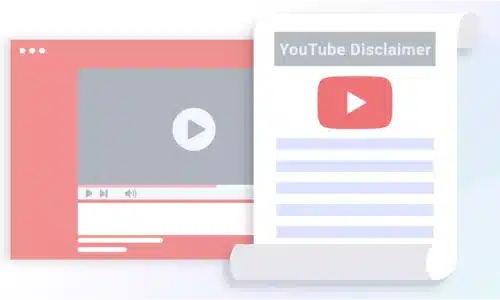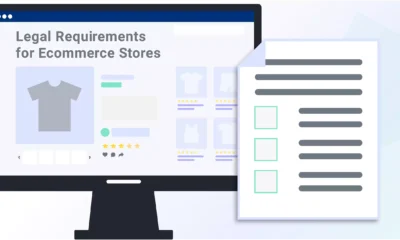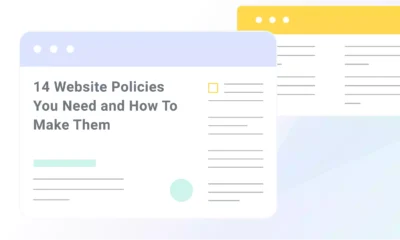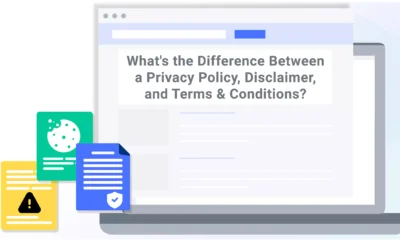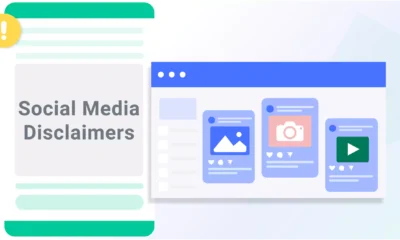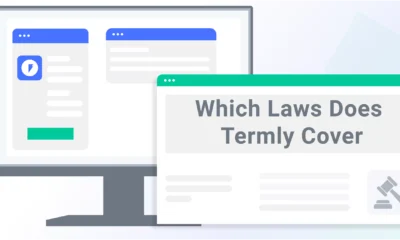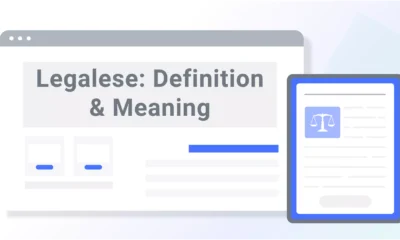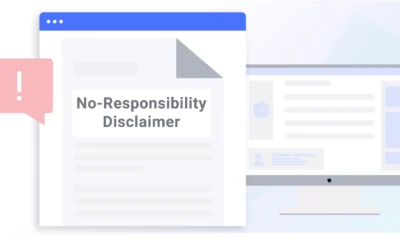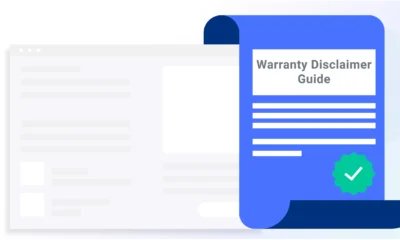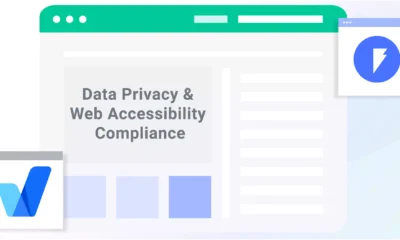Like and subscribe — and read the disclaimers, please.
A YouTube disclaimer is a statement made verbally in a YouTube video or written in the description that helps reduce various legal liabilities or provides protection for original content.
You may need a disclaimer if your YouTube videos provides advice, accepts sponsorships, features other people’s intellectual property, or your own copyrighted materials.
Below, I explain what a YouTube disclaimer is, why you need one, provide real YouTube disclaimer examples, and teach you how to move one for your Youtube videos.
What Is a YouTube Disclaimer?
A YouTube disclaimer is a statement that removes some of your liabilities, establishes your intellectual property rights, or expresses your fair use purposes for using copyrighted content.
For example, a YouTube disclaimer can explain the risks that might arise from using your content, announce the presence of copyrighted work in your video, or help protect you from lawsuits and prevent the undesirable reproduction of your creations.
When it comes to YouTube, you may need disclaimers for funny videos, serious content, reviews, advice or how-tos, sponsored vlogs, brand-related commercials, and more.
All of the following examples of disclaimers are particularly relevant for YouTube videos:
- Copyright disclaimer
- Fair use disclaimer
- Disclaimer for music
- Liability disclaimer
- Advice or views expressed disclaimers
- Medical disclaimers
- Affiliate link disclaimers
I’ll cover each of these disclaimers and why they’re important for YouTube videos in more detail later on, but first, let’s talk about why you should put one on your content.
Why Have a YouTube Disclaimer?
You should have a YouTube disclaimer posted somewhere alongside your video to help protect you and your content from:
- Being reused, reproduced, or redistributed without your permission
- Unfair copyright strikes
- Legal liabilities
- Being held responsible for how viewers interpret or use your content
- Trouble with the Federal Trade Commission (FTC) if you’re endorsing or sponsoring a product
The kind of disclaimer your YouTube video requires will depend on its content and what you hope to protect with it.
For example, posting a visible YouTube copyright disclaimer for your music can help discourage others from using it without permission.
Or, if your video borrows someone’s copyrighted content for fair use purposes, a fair use YouTube statement may protect you from unnecessary copyright infringement claims.
Similarly, using a YouTube liability disclaimer can help protect you from lawsuits that may arise from the use of any product, service, or advice you provide in your video.
YouTube Video Disclaimer Examples
There are several different types of disclaimers you might use for a YouTube video, all of which I’ve outlined in detail for you in this next section.
YouTube Copyright Disclaimer
A YouTube copyright disclaimer helps prevent the unauthorized use, redistribution, and theft of your video by establishing your intellectual property rights.
Although copyright protection automatically applies as soon as you create original content, a copyright disclaimer allows you to declare your rights and deter copyright infringement explicitly.
Below, see an example of a YouTube copyright disclaimer posted in the description of a music video from the channel TheCranberriesTV.

Including a copyright statement for your video is an additional layer of protection for your original work because it reminds viewers that you’re retaining rights over the content.
There is also a chance that some viewers aren’t aware of copyright laws, and without seeing a notice, they may falsely believe they can reuse or redistribute your video when that may not be the case.
YouTube Fair Use Disclaimer
Perhaps the most common disclaimer added to YouTube videos is for fair use, which, under Section 107 of the Copyright Act, allows the unlicensed use of copyrighted materials for purposes such as:
- Commentary: Using parts of a news article, scientific paper, or medical journal for educational purposes
- Criticism: Reviewing a movie and referencing scenes, or writing a music review and quoting the lyrics
- Parody: Mimicking, making light of, or satirizing something, usually in a comedic way
If you’re referencing someone else’s copyrighted materials, ensure it’s within the scope of fair use and cite the law directly in your disclaimer.
For example, the screenshot below of the description from The Cosmic Wonder’s YouTube video includes a fair use disclaimer because the creator features stills and footage from Marvel movies.
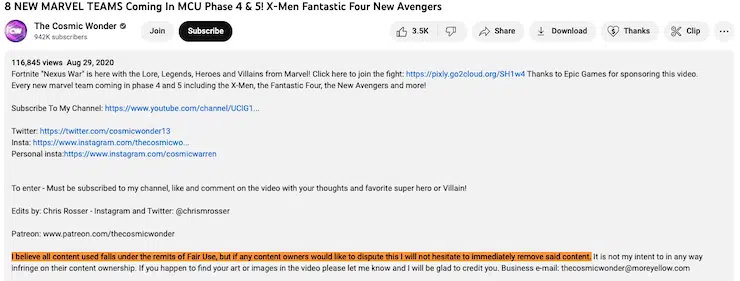
But in some cases, it may be valuable to put your fair use disclaimer directly within the video itself, like in the screenshot example below from documentarian YouTuber NOT THE GOOD GIRL.
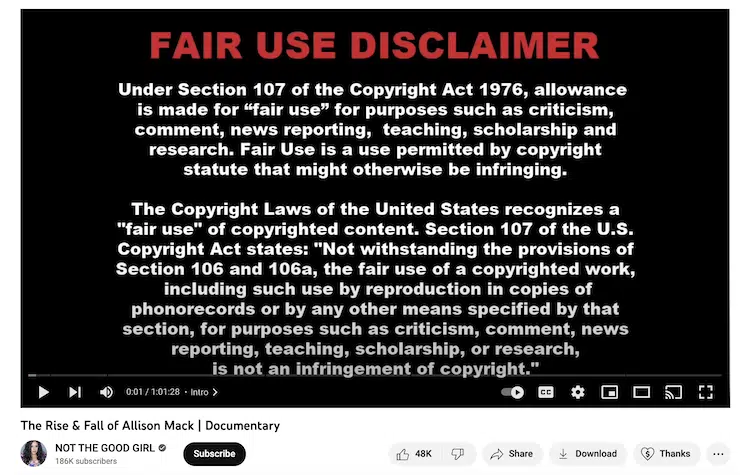
You should also understand that copyright laws vary from one country to the next.
For example, the fair use statement for YouTube videos applies to American laws but not UK or European guidelines.
It’s in your best interest to check on the copyright laws relevant to the country where the content you’re referencing is originally from.
YouTube Disclaimer For Music
You should use a YouTube disclaimer for music when you cover or sample someone else’s musical work to prevent or limit the risk of receiving a copyright strike.
In the screenshot below, see how musical YouTuber Adam Lee includes a music disclaimer in the description of his cover of Justin Bieber’s “Never Say Never”.
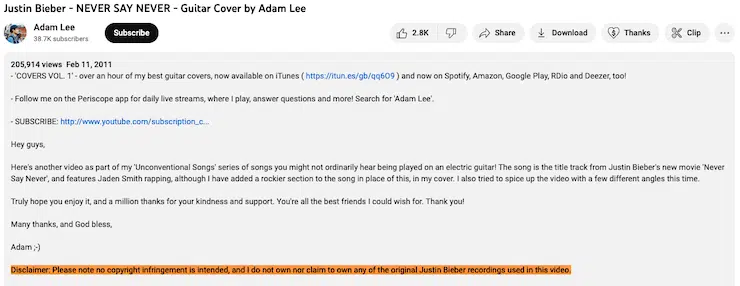
While using a YouTube disclaimer for music helps, it doesn’t guarantee that the original musician won’t pursue you for copyright infringement.
I recommend getting explicit permission from the owner of any content you’re referencing whenever possible.
But when that’s not feasible, add a music disclaimer to your YouTube video description whenever you feature music created by someone else.
YouTube Advice Disclaimers
If you post videos that provide any kind of perceived advice or expertise, you might need a YouTube advice disclaimer, especially for things like:
- Medical advice
- Fitness or health advice
- Legal advice
- Financial advice
A medical, legal, or financial advice disclaimer explains that the information you provide is not professional and viewers should only act on it at their own risk.
The screenshot below shows a legal advice disclaimer that the YouTube channel Gustitis Law includes in the description of one of their videos about traffic laws and drivers’ rights.

Their legal disclaimer specifies that the video content does not substitute real legal consultation.
If your video presents legal advice, explicitly express that no attorney-client relationship is formed through the video, as in the example above.
If your video presents health or medical advice, include an additional medical disclaimer stating that your content does not substitute professional medical advice and that no doctor-patient relationship is formed through the video.
You should add a similar statement if your videos provide financial information.
YouTube Limit of Liability Disclaimers
You can add a limit of liability disclaimer — also called a no-responsibility disclaimer — to your YouTube video to indicate that you’re not responsible for any damages that viewers experience from watching your content.
This disclaimer is more general than the previously mentioned advice disclaimers.
While it cannot prevent civil lawsuits, having one in place puts you in a better position if you need to defend yourself in a court of law.
The screenshot below shows a limit of liability disclaimer in the video description for a YouTuber called proclaimliberty2000, who provides how-to videos primarily focusing on vehicle maintenance.

YouTube Affiliate Link Disclaimers
If you post sponsored videos or use affiliate links, you need an affiliate link or testimonial disclaimer in the description of your video, or else you risk trouble with the Federal Trade Commission (FTC).
You should also verbally talk about the material relationship within the video, which includes whenever you receive a free product from a company or brand.
Below, see an example from commentary YouTuber Amanda the Jedi, who includes the following affiliate link disclaimer in the description of almost all of her videos.
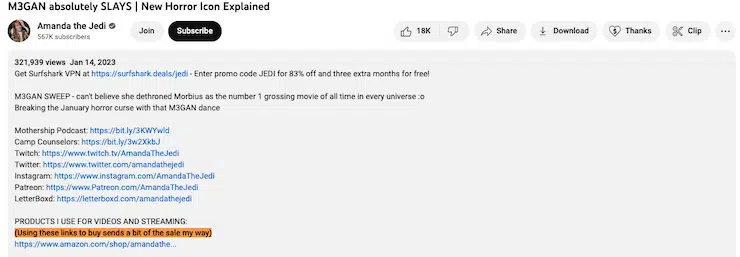
You should familiarize yourself with the other FTC disclosure guidelines that influencers must follow when endorsing products, as they also apply to YouTubers.
Benefits of Having a YouTube Disclaimer
You should have a YouTube disclaimer on your video for all of the following beneficial reasons:
- It helps limit your legal liabilities and responsibilities
- Disclaimers can protect and maintain your intellectual property rights
- You’ll minimize your risk of receiving unfair copyright infringement strikes
Let’s discuss each of these benefits in a little more detail.
YouTube Disclaimers Help Limit Liabilities
Adding disclaimers to your YouTube content can help reduce what you’re liable for, especially if your videos give any advice or professional expertise.
You should post a statement telling viewers that your video does not replace real professional advice and that acting on anything you say or do in the video should only be done at their discretion.
For the best effect, put any limits of liability disclaimers for your YouTube videos in the description box, the About page of your channel, or even directly in the video itself.
YouTube Disclaimers Protect Your Intellectual Property Rights
Putting simple YouTube copyright disclaimer text in the description of your video can help protect it from getting unfairly reproduced, reused, or copied without your permission.
For example, some viewers may not realize that your video is protected by copyright, and a disclaimer is a visual reminder that you’re retaining rights over your content and are prepared to take legal action if anyone misuses your work.
If you already have a copyright notice on your website, copy and paste it directly into the description of your YouTube videos.
YouTube Disclaimers Reduce Unfair Copyright Infringement Strikes
If you’re referencing someone else’s copyrighted materials in your YouTube video, adding a fair use disclaimer can help reduce your chances of receiving a copyright strike.
While it can’t guarantee that you won’t receive an infringement notice, it gives you something to point to as proof that you are aware of the laws, acted in good faith, and never intended to misuse the original author’s work.
How to Write a Disclaimer for YouTube
You can write disclaimers for YouTube from scratch, just be sure to keep your audience in mind and include the disclaimers that are most relevant to your content.
For example, if you’re not referencing someone else’s copyrighted work in your video, you don’t need to write a fair use disclaimer for your YouTube video.
But I recommend customizing a disclaimer template to address relevant rights, responsibilities, and liabilities related to your YouTube video for the following reasons:
- Reason #1: Templates are usually free to download and are fully customizable, so you can adjust them to fit the needs of your YouTube channel without spending an arm and a leg
- Reason #2: Well-written disclaimers already have the initial writing done for you, saving you time and helping ensure you don’t miss anything important
- Reason #3: It’s typically much faster to use a template than it is to create your disclaimer entirely from scratch
Or you can save even more time and use our fast and easy Disclaimer Generator.
That said, if you post high-liability content or are particularly vulnerable to copyright lawsuits, it may be in your best interest to consult legal counsel.
Where To Display a YouTube Disclaimer
Display your YouTube video disclaimer in places where viewers can easily find it, such as:
- In the YouTube video description box
- On the ‘About’ section of your YouTube channel
- In a clause in the terms and conditions agreement posted on your website or mobile app
- Verbally stated in the actual content of your video
Let’s go over why each of these are important places to display a YouTube disclaimer in more specific detail in the following sections.
YouTube Disclaimers in the Description Box
The first place most viewers look for more information about YouTube videos is the description box, so it makes sense to put all of your relevant disclaimers there.
Below is another example from commentary YouTuber Amanda the Jedi, who follows the FTC endorsement guidelines by posting her affiliate disclaimer above the “Show more” button.

Another benefit to putting disclaimers in your YouTube video description?
You can point to the information to help prove your case if you’re wrongfully copyright struck, if someone tries to steal your content, or if a viewer tries to hold you legally accountable for the information presented in your video.
YouTube Disclaimers in the ‘About’ Section of Your Channel
Your YouTube user page has all of your videos collected in one place and features an ‘About’ section, so it’s an excellent place to include any disclaimers you wish to apply to all your videos.
For example, The Film Theorists are a movie review YouTube channel that sometimes feature fan art in their content, so they include the following disclaimer in their ‘About’ page that applies to all videos posted on their channel.
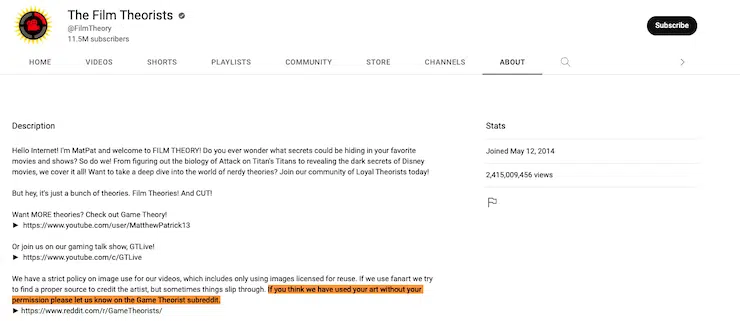
But it’s important to note that posting a disclaimer in the ‘About’ section of your channel should not take the place of putting specific disclaimers on individual videos or Youtube Shorts, like fair use or advice disclaimers.
When in doubt, put your YouTube disclaimer in multiple areas.
Verbally State Your Youtube Disclaimers
Another way to ensure your viewers are aware of your YouTube disclaimers is to verbally state them directly in the video itself.
This is especially important if your video is sponsored or if you need to disclose an endorsement.
Below, see a screenshot from a video posted by gaming YouTuber: The Completionist.
He vocalizes his sponsorship with Marvel Snap immediately, so viewers are aware of the endorsement, and puts the link above the “Show more” button, following FTC guidelines.
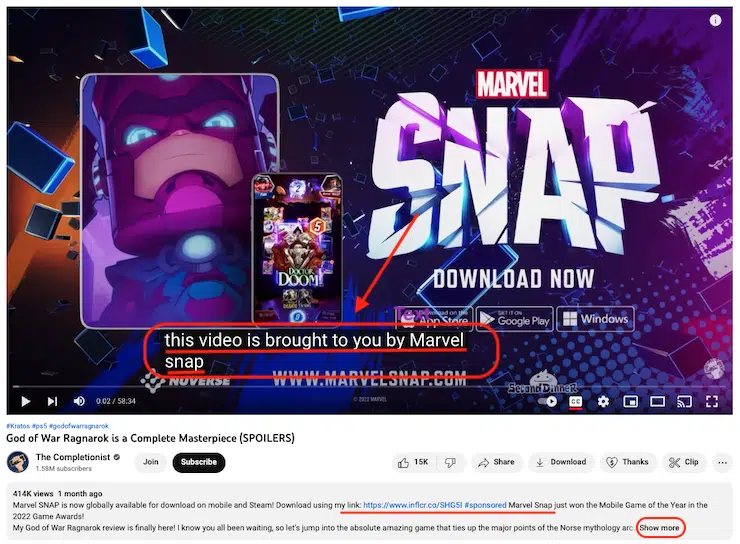
YouTube Disclaimer in Your Terms and Conditions Agreement
If you post videos on YouTube and also have a website, you can expand upon your YouTube disclaimers within clauses in your terms and conditions agreement.
This gives you plenty of space to explain additional information that may be relevant to your disclaimers but doesn’t necessarily fit in the description box or About page, like:
- How you use affiliate links
- Ways to contact you if a user suspects someone copied or misused your work
- Required legal phrasing to appropriately limit your liabilities
Just remember, not everyone who sees your videos comes from your website. So be sure you’re also posting the disclaimers somewhere obvious for the people who only visit your YouTube channel.
How To Add Disclaimers to Your YouTube Videos
In the next sections, I walk you through the steps of adding a YouTube disclaimer to your video description, your ‘About’ page on your channel, and in the video itself.
How to Add a YouTube Disclaimer to the Video Description
To add a disclaimer to the description of your YouTube video, start by logging into your channel dashboard and select Content from the menu on the left side of the screen, like what is shown below.
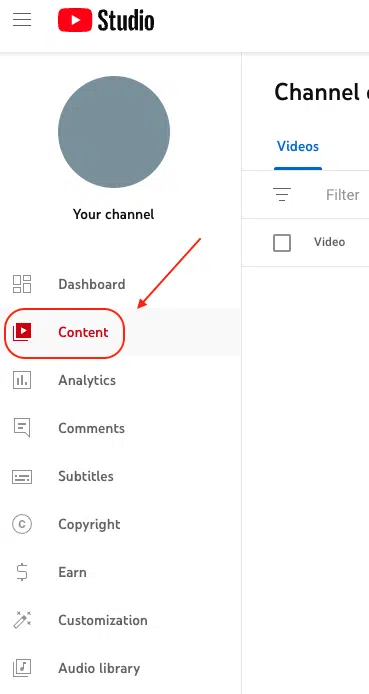
If you want to update a video already uploaded to your channel, find the correct one and select Edit.
Otherwise, do this same step while adding a new video to your channel.
Either method will bring you to a page that looks like the one pictured below.
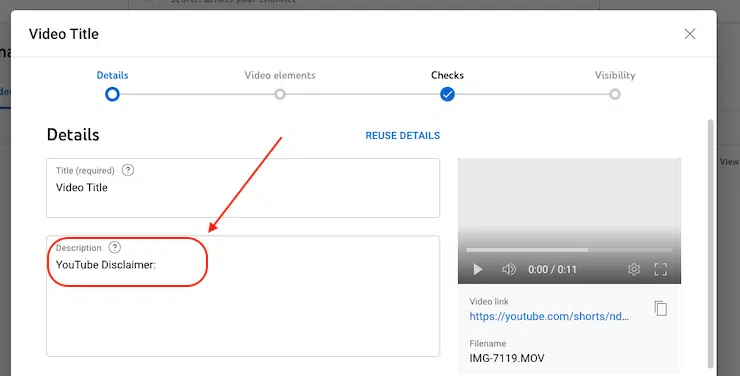
If your disclaimer is hosted on a URL, you can paste that link directly into the Description box. But you can also manually type out your disclaimer, as shown below.
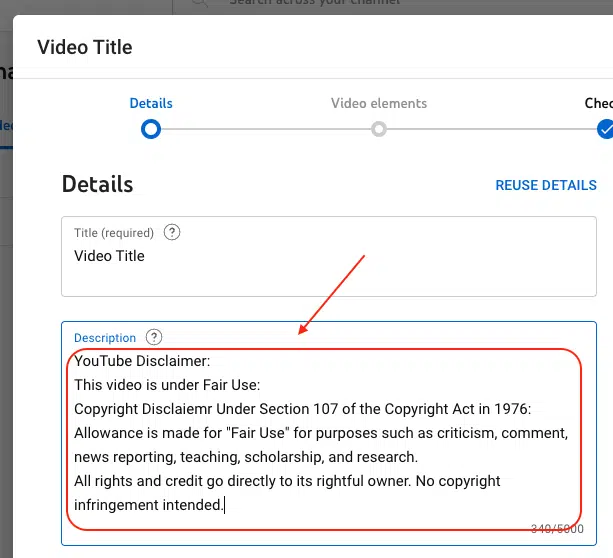
Once you’ve finished, click Save in the top right corner of your dashboard and click on your video.
You’ll now see a successfully uploaded disclaimer in the updated description of your YouTube video.
How to Add a YouTube Disclaimer to your ‘About’ Page
To add a YouTube disclaimer to your About page, access your YouTube studio and select Customization from the menu bar on the left side of the screen, shown below.
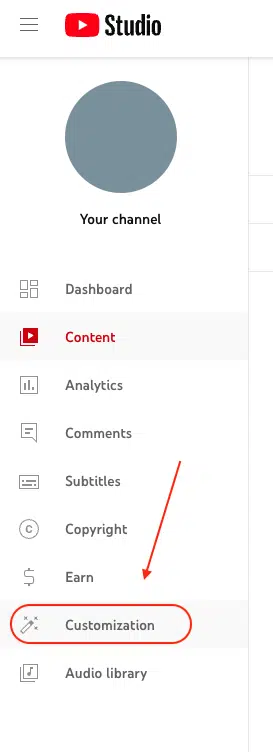
Then navigate to the Basic Info tab, as shown below in the screenshot.

Once you’re on the next page, add your disclaimer directly to the Description box. You can simply copy and paste the link if you host your disclaimers in URLs.
Otherwise, write the disclaimer info in the dedicated text box shown below.
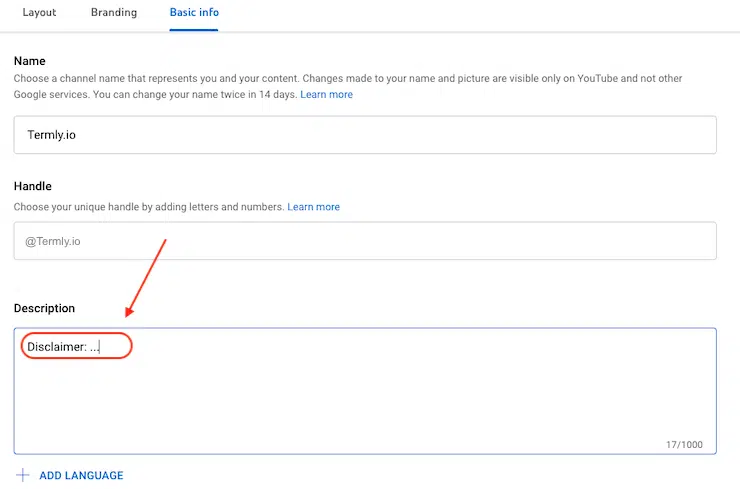
Once you’ve inputted the appropriate disclaimers, click on Publish in the top right corner of the screen and go to your channel.
You’ll now successfully see the disclaimer information in the About tab of your YouTube channel.
How to Add a YouTube Disclaimer Directly in Your Video
To add a YouTube disclaimer directly into your video, you should do both of the following:
- Verbally state your disclaimer
- Put the text of the disclaimer on the screen
Record a clip of yourself saying whatever you would otherwise write for your disclaimer. At the same time, consider putting a notice on the screen that looks like the fair use disclaimer included in the example from NOT THE GOOD GIRL above.
This is a valuable disclaimer disclosure method for the following reasons:
- Your video Features fair use content
- You want to warn others not to copy what they see you doing in the video
- The video is sponsored and you’re endorsing a product
YouTube Disclaimer FAQ
Below, you can check out some of the most frequently asked questions we get about YouTube disclaimers.
What is a YouTube disclaimer?
YouTube disclaimers are statements placed on your YouTube video or in the description that help reduce your legal liabilities or provide protection for your original content.
Where should I display my YouTube disclaimer?
You should display your YouTube disclaimers in the description of your videos, on your YouTube channel About page, and within the video itself whenever it’s relevant to do so.
Is a YouTube disclaimer legally required?
While a YouTube copyright or fair use disclaimer is not legally required, you must follow the Endorsement Guidelines outlined by the FTC if you’re in the US and do sponsorships in your videos.
Is a YouTube disclaimer legally binding?
A YouTube disclaimer on its own is not legally binding but instead informs viewers about what you are or aren’t responsible for.
However, if anyone ever does try to misuse your content, you can point to the disclaimer as proof that the perpetrator should’ve been aware of your copyright, fair use, or other YouTube disclaimer.
Summary
If you post videos on YouTube, there are plenty of different reasons why you might need one or more disclaimers.
They help limit your liabilities, protect your original content, express your fair use of someone else’s copyrighted materials, and to inform users that your videos should not be taken as professional advice and following your content is at the risk of the viewer. They’re also vital if you ever post sponsored videos or endorsements.

